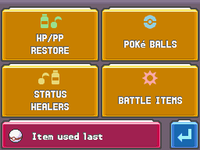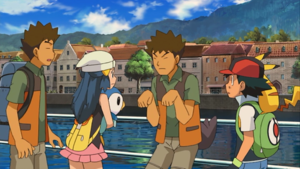Bag
The Bag (Japanese: バッグ bag), referred to on the menu as ITEM (Japanese: どうぐ tool) in Generation I and PACK (Japanese: リュック rucksack) in Generation II, is a vital tool in all main series Pokémon games. It holds all of the player's items, storing them for later use. By opening the Bag, players can use, arrange, and toss most items, and register key items for easy access.

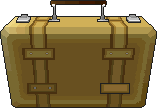
Use
Outside of battle
The Bag appears as part of the start menu in all main series games, as well as in Pokémon Colosseum and Pokémon XD: Gale of Darkness. In Generation I as well as in Colosseum and XD, it is accessed with the "ITEMS" command, while in Generation II, it is accessed with the "PACK" command.
All items that the player has on hand will be located in the Bag and, after Generation I, being placed in the appropriate pocket automatically. Prior to Generation IV, the items pocket had only 20 spaces for items, while the other pockets had space for any and all items that would go there. If an item to be picked up would be placed into the items pocket, however, and the pocket was full, it could not be picked up until the player had deposited some items into the PC. This problem no longer exists in Generation IV and beyond, where all pockets have enough space for every item.
Inside of the Bag menu, the player will find a list of all their items, ordered by default from the first kind obtained to the most recently obtained. Players may rearrange these items with the select button, except in the Berries and TMs and HMs pockets, which are automatically ordered. Depending on the type of item, and sometimes on the item itself, options exist when it is selected that allow players to use the item, throw the item away, register it on the Select/Y button for use on the field, or have a Pokémon hold it.
In battle
The Bag is also one of the four menu selections during a Pokémon battle, and allows the player to use items that can be used in battle, such as Poké Balls, Potions, and items like X Attack. Prior to Generation IV, the Bag menu during battle was the same as that outside of battle, allowing inventory checking of items that are unrelated to battle during it. In Generation IV, however, it became a completely different menu on the touch screen, split into four categories of use.
Using an item while in battle uses up a turn. This only occurs if the item that is used, of course, does anything during the battle (for example, in Generation II, attempting to use a NeverMeltIce will lead only to the player being scolded by Professor Oak). Items cannot be used in linked battles or in facilities such as the Battle Tower.
The item that was last used during battle, if there were multiple copies of it in the Bag, can be easily used again. The selection cursor will remain on it in Generation I-III games, while a shortcut menu will exist at the lower left corner of the screen to the last used item in Generation IV and V.
Differences between generations
While the Bag has remained a consistent part of the menu screen for all five generations, significant changes have been made to its structure in each later generation, with most welcomed as improvements.
Generation I
In Generation I, the Bag began as a simple list of items, with only 20 different kinds ever allowed to be held on-hand at one time. Additional items that the player owned would need to be stored in the player's PC, accessible from any Pokémon Center, but would need to be put there manually, as picked up items that did not fit in the Bag would simply be left where they were, but could be picked up at a later time, when there was space for them. Up to 99 of any one item could normally be held in the Bag, with additional amounts of an item taking up a second slot (for example, in order to have 103 Great Balls on hand, one would need to have one slot of them ×99, and another with them ×4); this was not totally concrete, however, and the Item duplication glitch involving Missingno. could be performed in Pokémon Red and Blue, allowing for 128 of the same item to be held in the same Bag slot.
Generation II
The Bag received its first major overhaul in Generation II, where items were now separated into four pockets. While the items pocket held most of the different types of item still, the other three pockets were more specialized, and could contain all items of their specific type, allowing for better access to these items. Each item also received an in-Bag description.
Items |
Balls |
File:GSC Key items pocket.png KeyItems |
TM/HM |
| Contains all items not in other pockets. | Contains all 11 varieties of Poké Ball available in Generation II. | Contains all key items. | Contains all TMs and HMs. |
Generation III

|
This section is incomplete. Please feel free to edit this section to add missing information and complete it. Reason: how exactly the color of icon differs |
Another overhaul for the Bag came in Generation III, adding one further pocket that did not exist in Generation II. This pocket, much like the Poké Balls pocket, was created in response to the large overhaul to the Berry system from Generation II, allowing all 43 Berries to be kept in the Bag at once, organized by their Berry number.
A visual of the Bag itself was added to the screen, replacing the blueprint-like structure present in Generation II, and for the first time, male and female player characters had a different Bag design. In Pokémon Ruby and Sapphire, the Bags are yellow, but in Emerald, they are green.
Additionally, Emerald uses the Battle Bag in the Battle Pyramid. The color of the icon differs.
Ruby, Sapphire, and Emerald
♂/♀ Items |
♂/♀ Poké Balls |
♂/♀ TMs and HMs |
♂/♀ Berries |
♂/♀ Key items |
| Contains all items not in other pockets. | Contains all 11 varieties of Poké Ball available in Generation III. | Contains all TMs and HMs. | Contains all Berries. | Contains all key items. |
Emerald
| File:Battle Bag Emerald.png |
| Contains items acquired in the Battle Pyramid. |
Colosseum and XD
In Colosseum and XD the bag is divided as it is in Ruby and Sapphire. The only noticeable differences in function are that in the event of a full bag, any new items are automatically sent to the PC, rather than left alone, and that key items can not be registered (as none that can be used on the field are present).
FireRed and LeafGreen
In FireRed and LeafGreen, the Bag's five pockets were condensed into three, with two key items, the Berry Pouch and TM Case, serving the role that the Berries and TMs and HMs pockets do in Hoenn-based games. A small icon was also given to each item, displaying it in the Bag alongside the description, which was lengthened. These Bag icons were also used in Emerald.
♂/♀ Items |
♂/♀ File:FRLG Key items pocket M.pngFile:FRLG Key items pocket F.png Key items |
♂/♀ Poké Balls |
| Contains all items not in other pockets. | Contains all key items. | Contains all 11 varieties of Poké Ball available in Generation III. |
Generation IV
The Bag was revamped once again in Generation IV, not only allowing for infinite space (and making the PC storage system for items obsolete) but also splitting the pockets up further than in Generation III. Three new pockets were split off from the Items pocket, making for a total of eight pockets. The Bags are yellow in Diamond and Pearl, but gray/silver in Platinum.
In Pokémon Diamond, Pearl, and Platinum, the Bag retained the list-like format from Generation III, with pocket-changing controls as well as a Poké Ball-shaped scrollwheel being present on the bottom screen. Due to the large quantity of items obtainable in the game (well over 100) that are stored in the Items pocket, many complaints about this system led to a complete revamp in Pokémon HeartGold and SoulSilver, which make further use of the touch screen compared to their predecessors, and group the items into six-cell pages. Additionally these games have Ethan/Lyra holding the bag with pocket being highlighted (oddly enough Lyra's Mail and Battle items' pockets show a hole in part of her back), while other games just show pockets.
Diamond, Pearl and Platinum
♂ ♀  Items |
♂ ♀  Medicine |
♂ ♀  Poké Balls |
♂ ♀  TMs and HMs |
♂ ♀  Berries |
♂ ♀  |
♂File:Pt Battle items pocket M.png ♀File:Pt Battle items pocket F.png Battle items |
♂File:Pt Key items pocket M.png ♀File:Pt Key items pocket F.png Key items |
| Contains all items not in other pockets. | Contains all healing and permanent stat-enhancing medicines. | Contains all available varieties of Poké Ball. | Contains all TMs and HMs. | Contains all Berries. | Contains all Mail. | Contains all items which only have effect in battle. | Contains all key items. |
HeartGold and SoulSilver
♂ ♀  Items |
♂ ♀  Medicine |
♂ ♀ 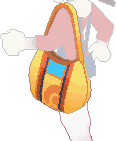 Poké Balls |
♂ ♀  TMs and HMs |
♂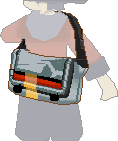 ♀  Berries |
♂ ♀ 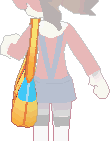 |
♂File:HGSS Battle items pocket M.png ♀File:HGSS Battle items pocket F.png Battle items |
♂File:HGSS Key items pocket M.png ♀File:HGSS Key items pocket F.png Key items |
| Contains all items not in other pockets. | Contains all healing and permanent stat-enhancing medicines. | Contains all available varieties of Poké Ball. | Contains all TMs and HMs. | Contains all Berries. | Contains all Mail. | Contains all items which only have effect in battle. | Contains all key items. |
Generation V
In Black and White, the Bag was overhauled again, with eight pockets being condensed into five, much like in Ruby, Sapphire, and Emerald. The pockets are called Cases in these games, and are labeled Items, Medicine, TMs & HMs, Berries and Key Items, with Poké Balls, Mail, held items and other items all being placed in the Items pocket. Held items, Mail and Poké Balls are indicated as such by an icon displayed to the immediate left of the item that corresponds to what type of item it is.
In these games, recently-acquired items (other than TMs) are added at the top of their respective item list (rather than the bottom, as in previous generations), and players can sort a pocket automatically by pressing Start, in addition to manual sorting with Select.
In Black 2 and White 2, a Free Space section was added to the Bag and the icon takes on the appearance of a smaller Bag. Players can select items they use most and add them to Free Space for easy access. Manual sorting can not be performed in this section and items are always placed in alphabetical order. However the player can filter the kind of items they want to see with the sorting button.
Unlike in the first pairs, new items go at the bottom of the item list like in previous generations rather than the top, including TMs and HMs. More sorting options were also added.
Black, White, Black 2, and White 2
♂ ♀ 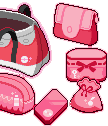 Items |
♂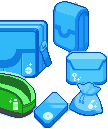 ♀ 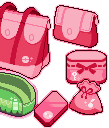 Medicine |
♂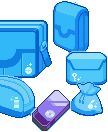 ♀ 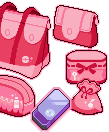 TMs and HMs |
♂ ♀  Berries |
♂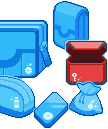 ♀  Key Items |
♂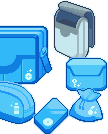 ♀ 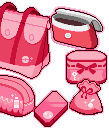 Free SpaceB2W2 |
| Contains all items not in other cases. | Contains all healing and permanent stat-enhancing medicines. | Contains all TMs and HMs. | Contains all Berries. | Contains all key items. | Contains selected frequently used items. |
In the anime

All of the main characters in the Pokémon anime own a Bag in which they keep their supplies and Poké Balls. While both of May's bags were designed based on the ones worn by her game counterpart in Generation III, and Ash's Bag in the Diamond & Pearl series is based on Lucas's, but colored green, the other main characters' Bags have little to do with their game counterparts, with Dawn taking a backpack rather than the Bag used by her game counterpart, and Brock, Misty, Iris, and Cilan having no Bags in the games.
By far, Brock's Bag has been shown to be the most spacious, having a full tea set and table inside in The School of Hard Knocks, as well as containing, presumably, everything he needs to cook meals on the road for his friends.
Gallery

|

|
File:GenIIIBag.png | File:FLBag.png |
| Generation I | Generation II | RSE | FRLG |
|---|---|---|---|
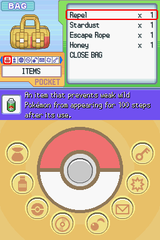
|
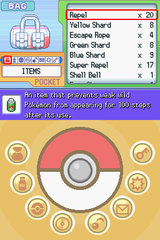
|
File:HGSSbag.png | 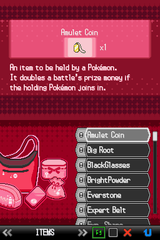
|
| DP | Pt | HGSS | BW |
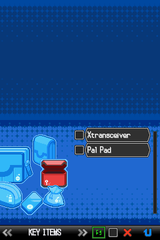
| |||
| B2W2 |
| |||||||

|
This item article is part of Project ItemDex, a Bulbapedia project that aims to write comprehensive articles on all items. |

